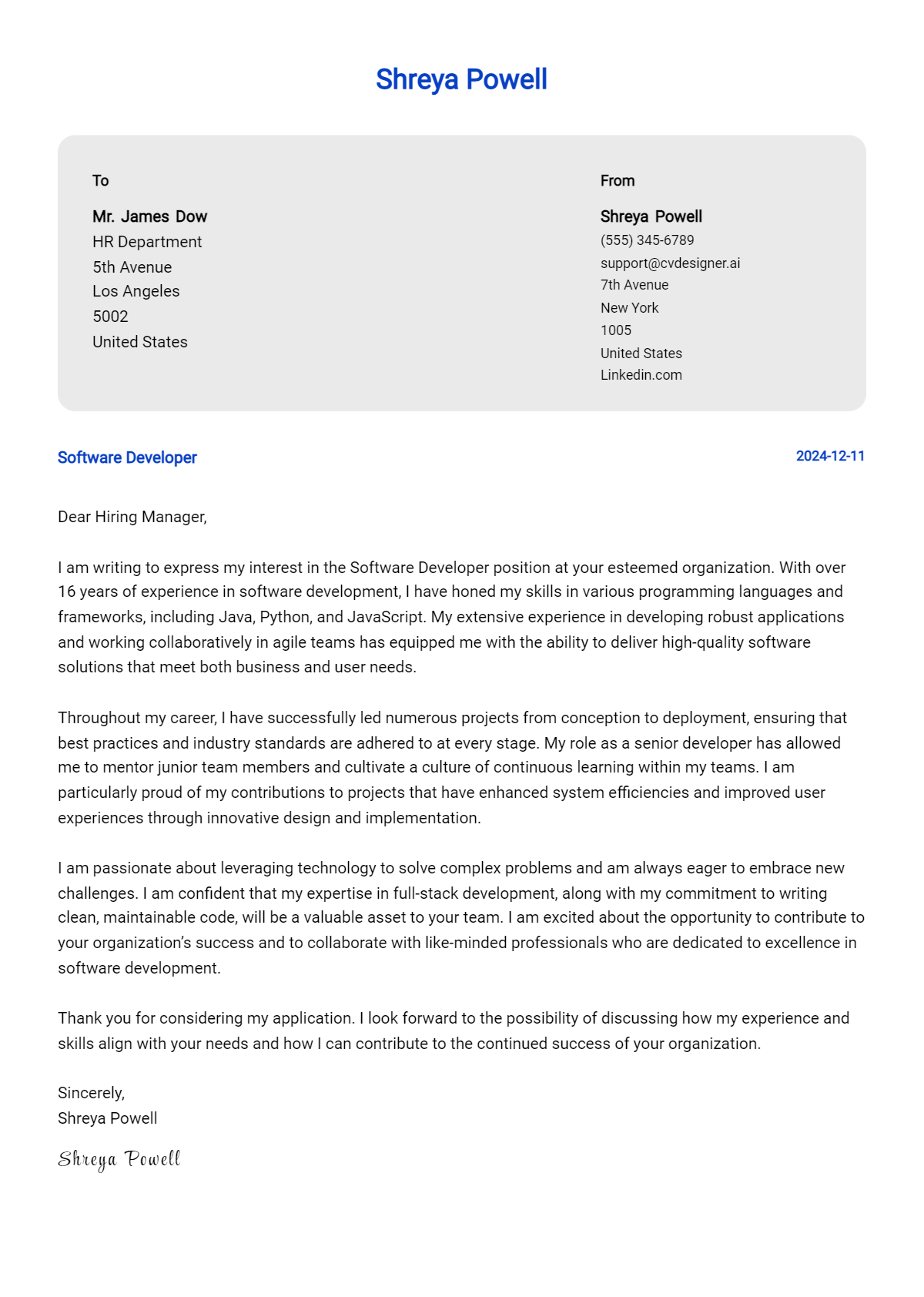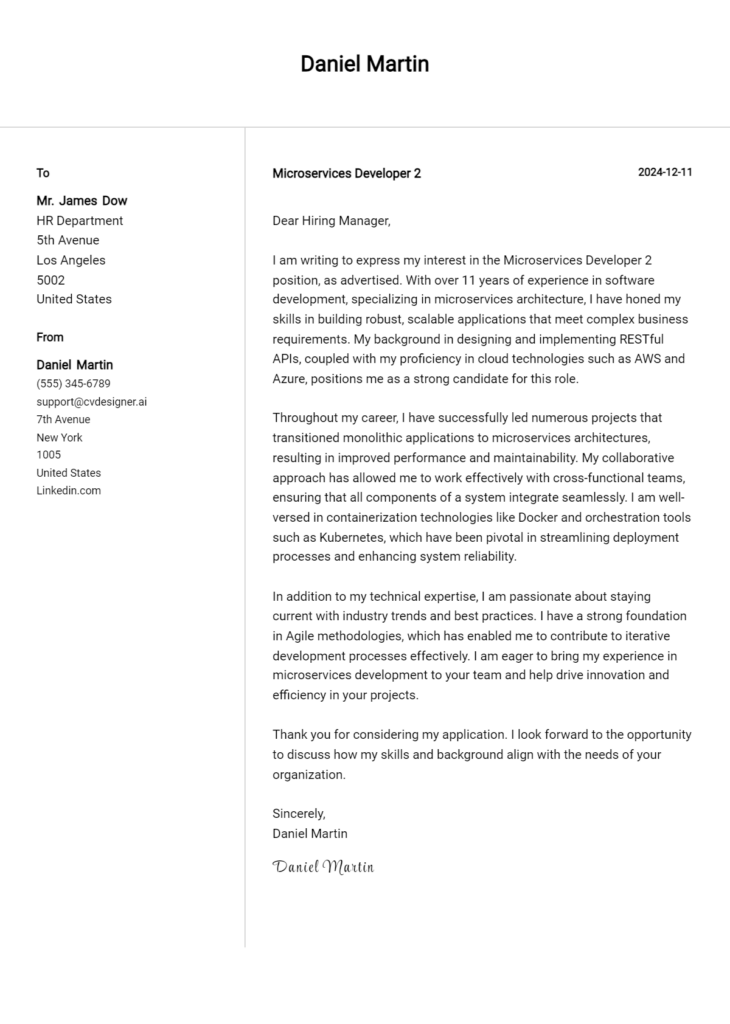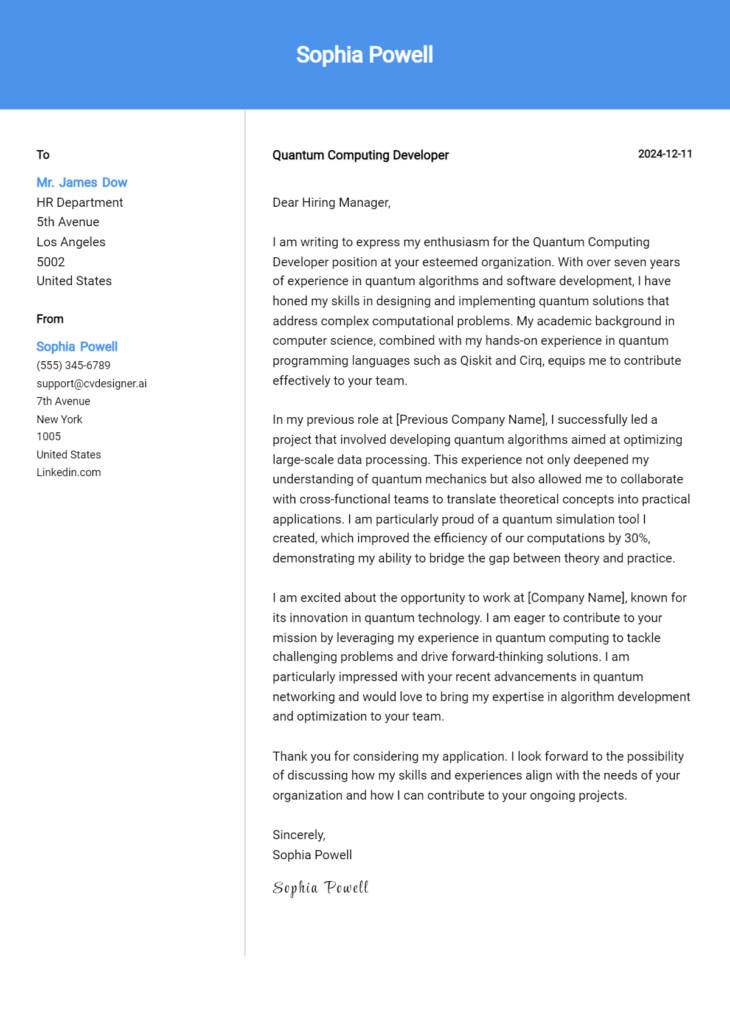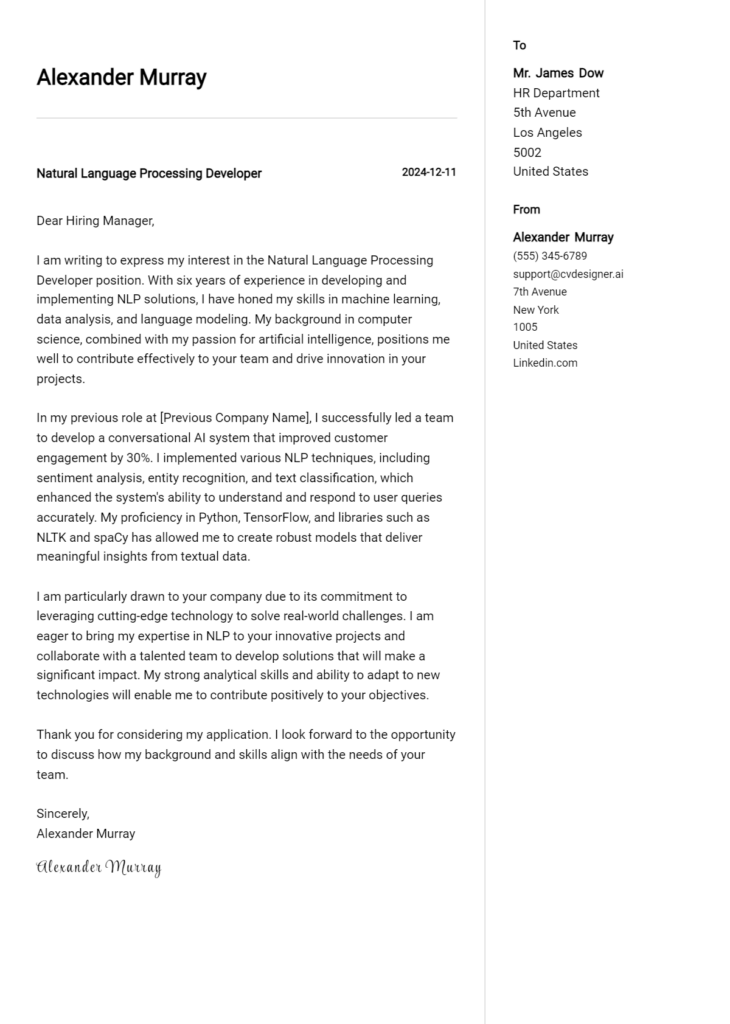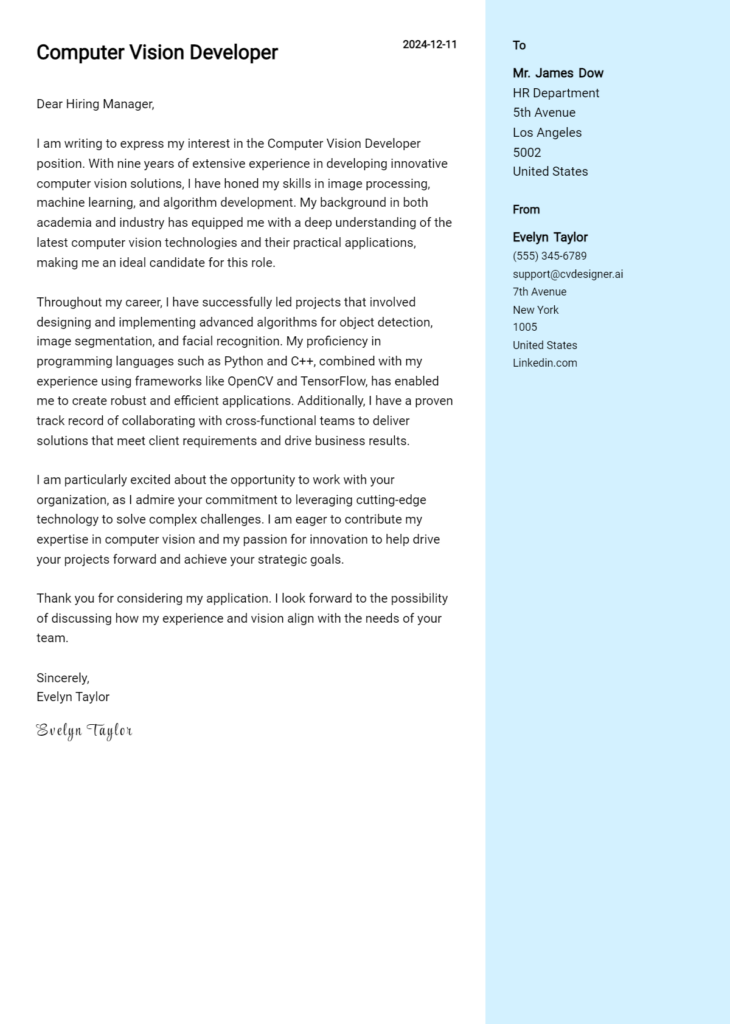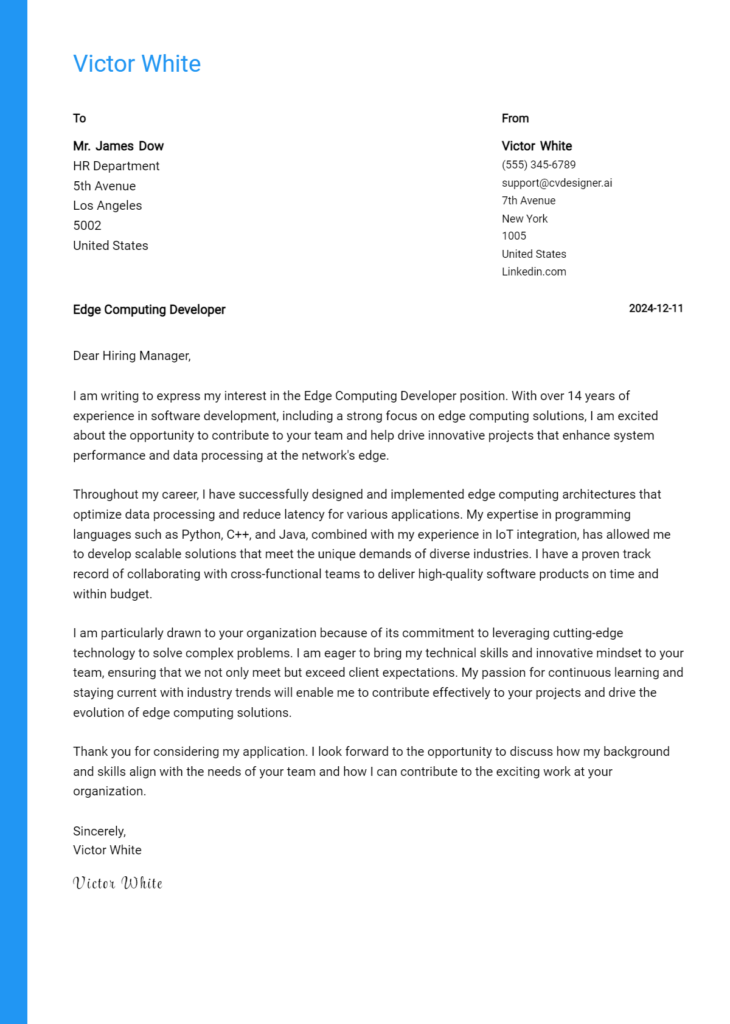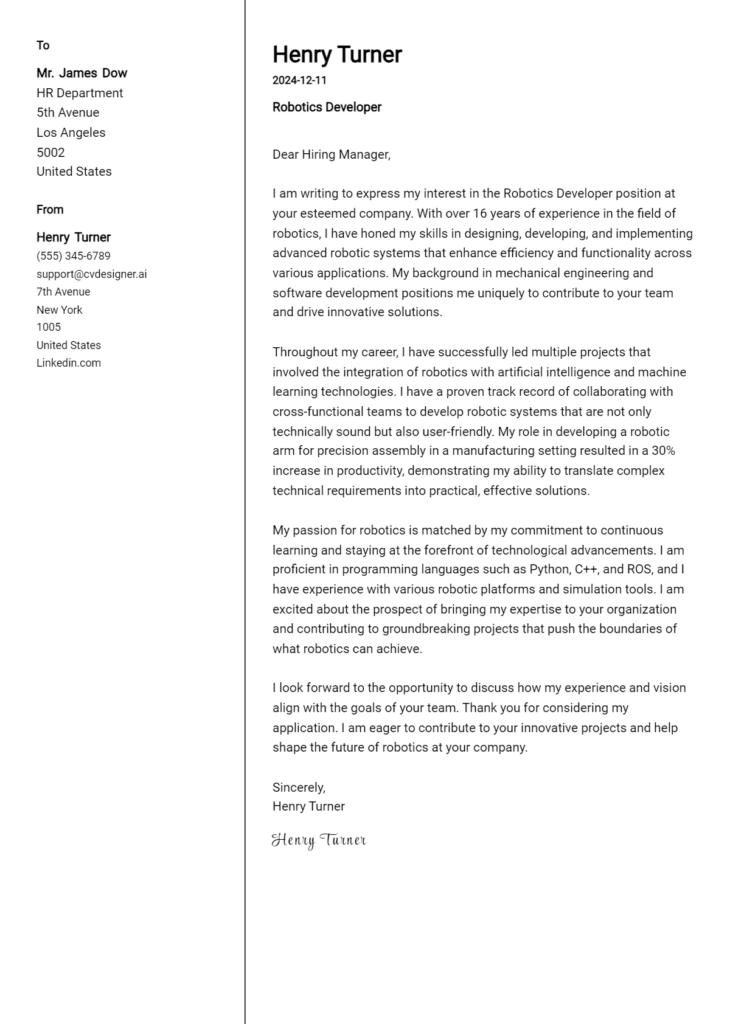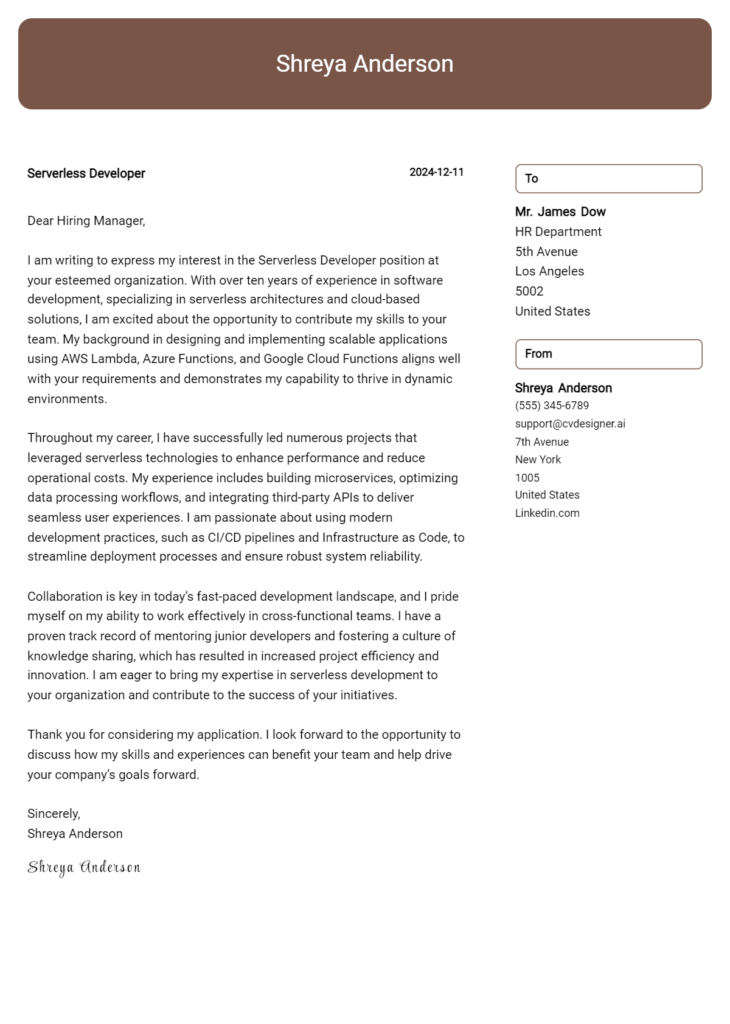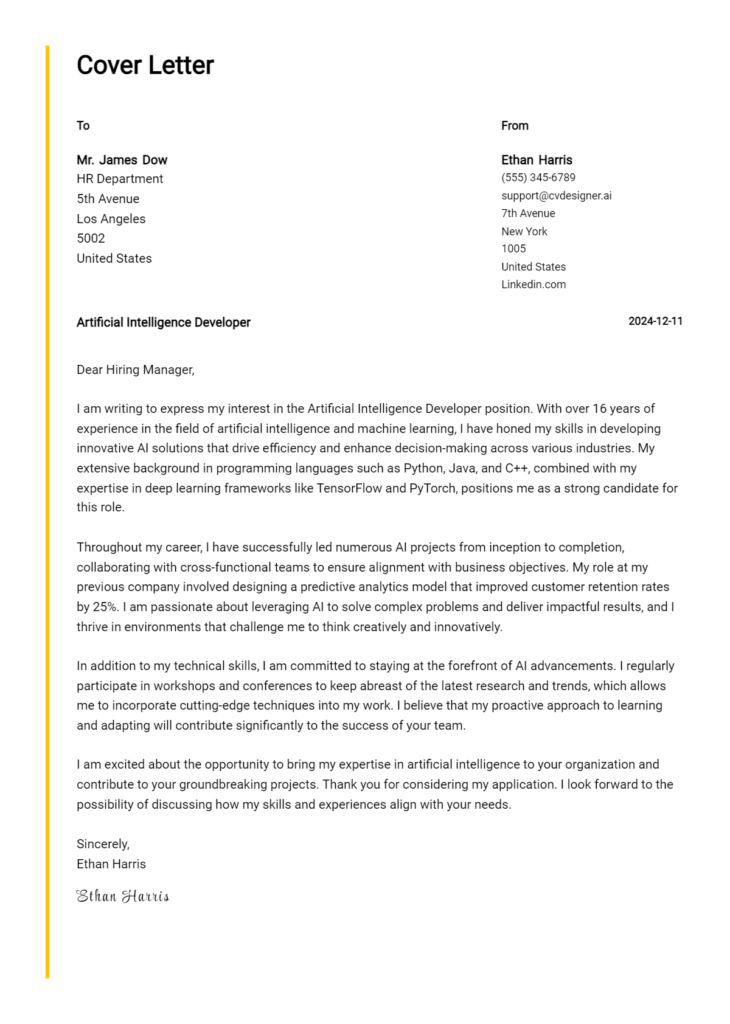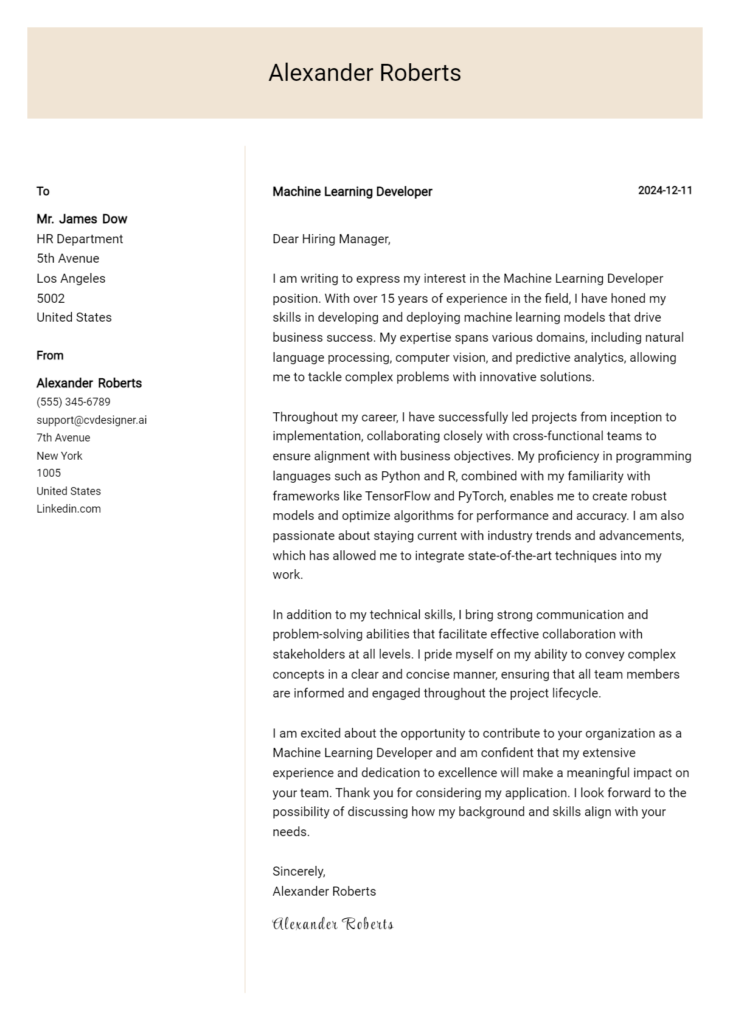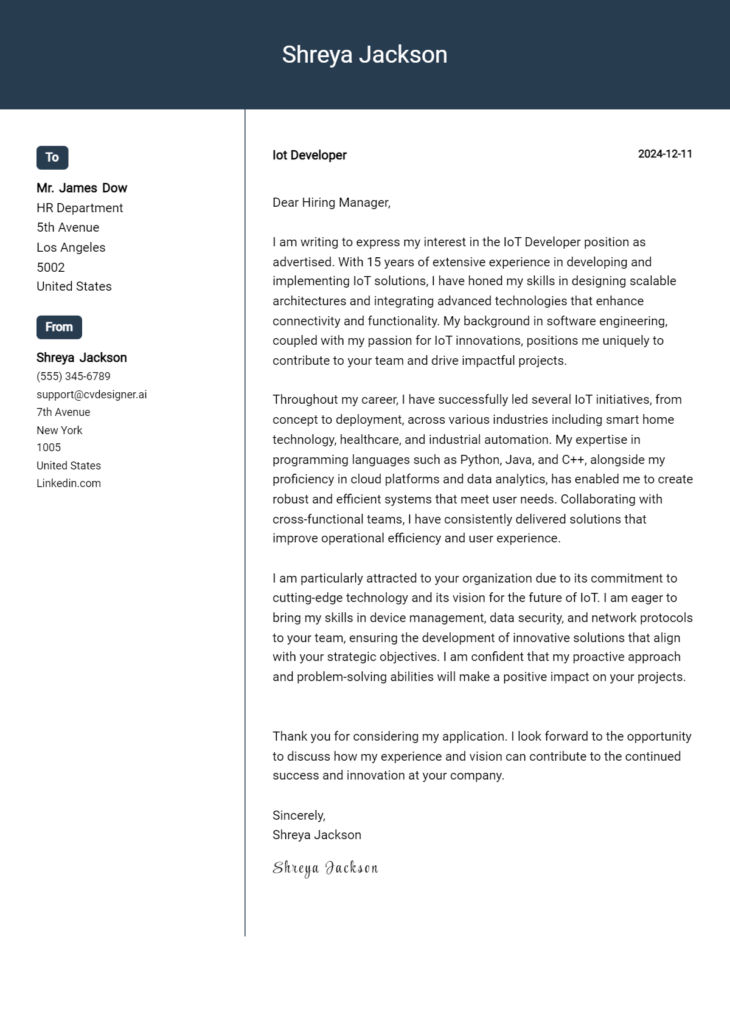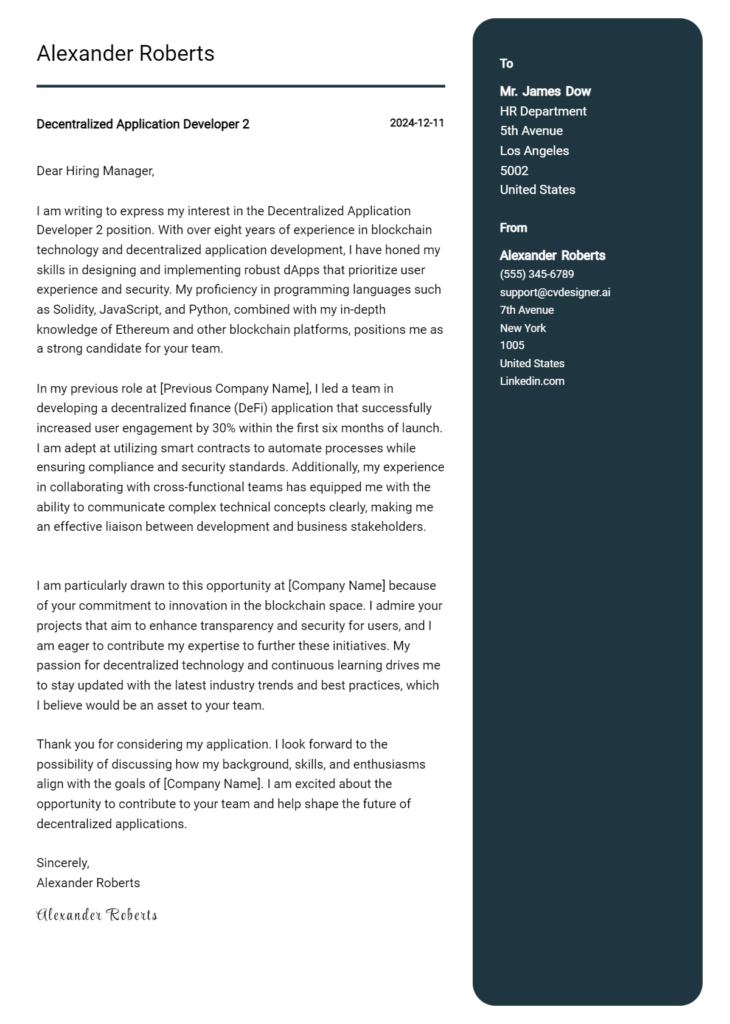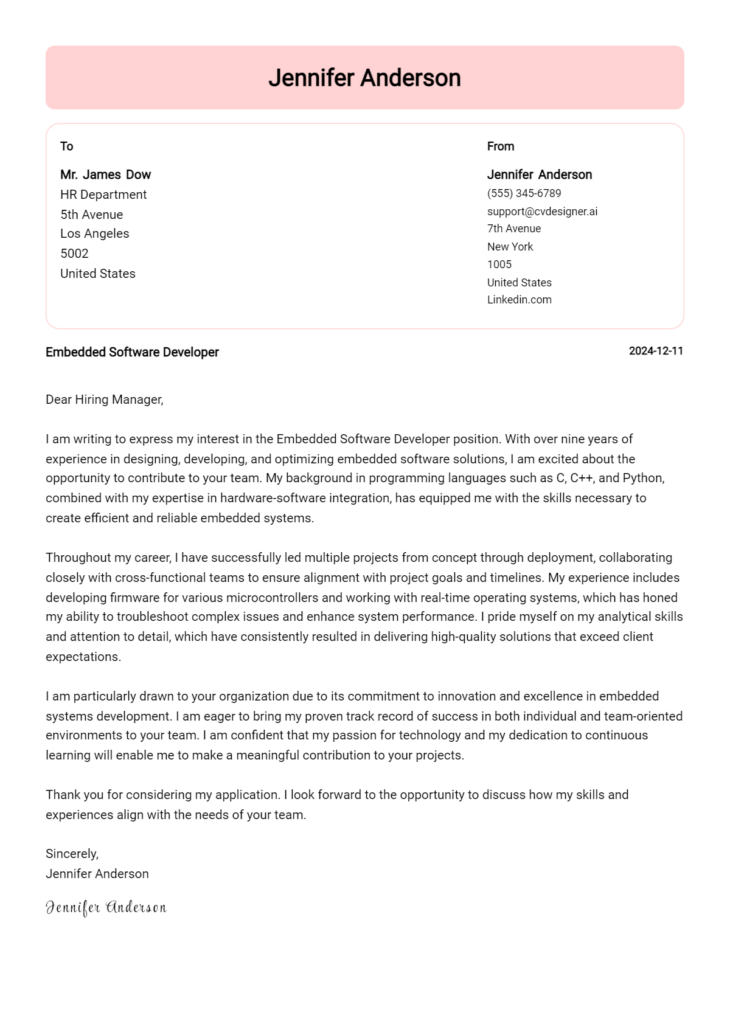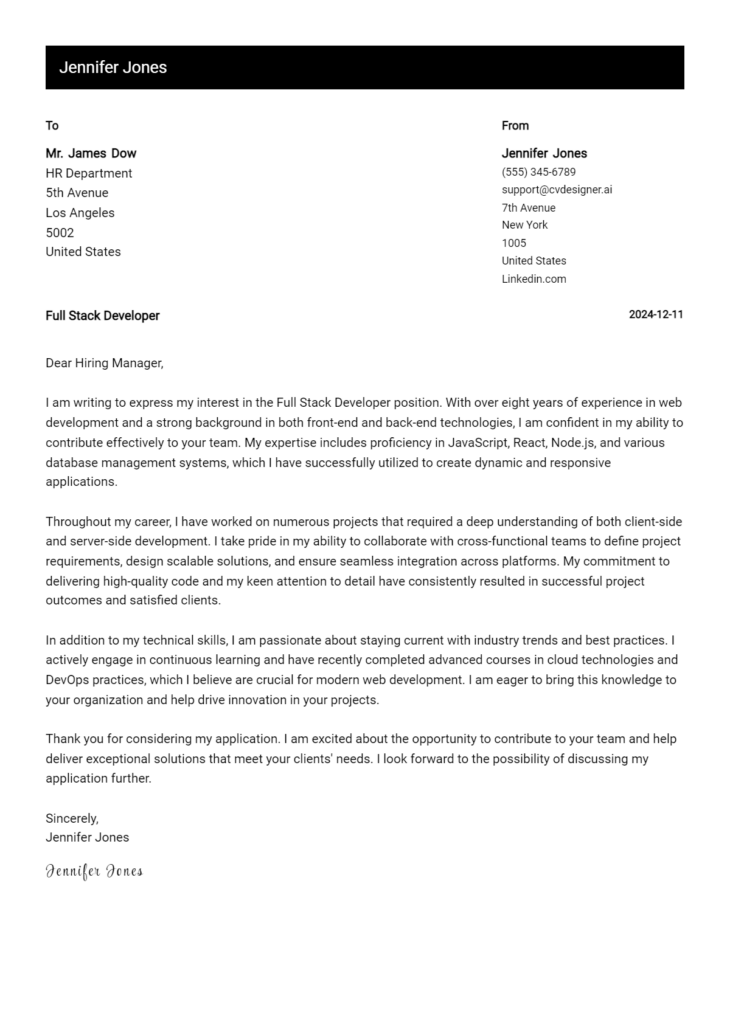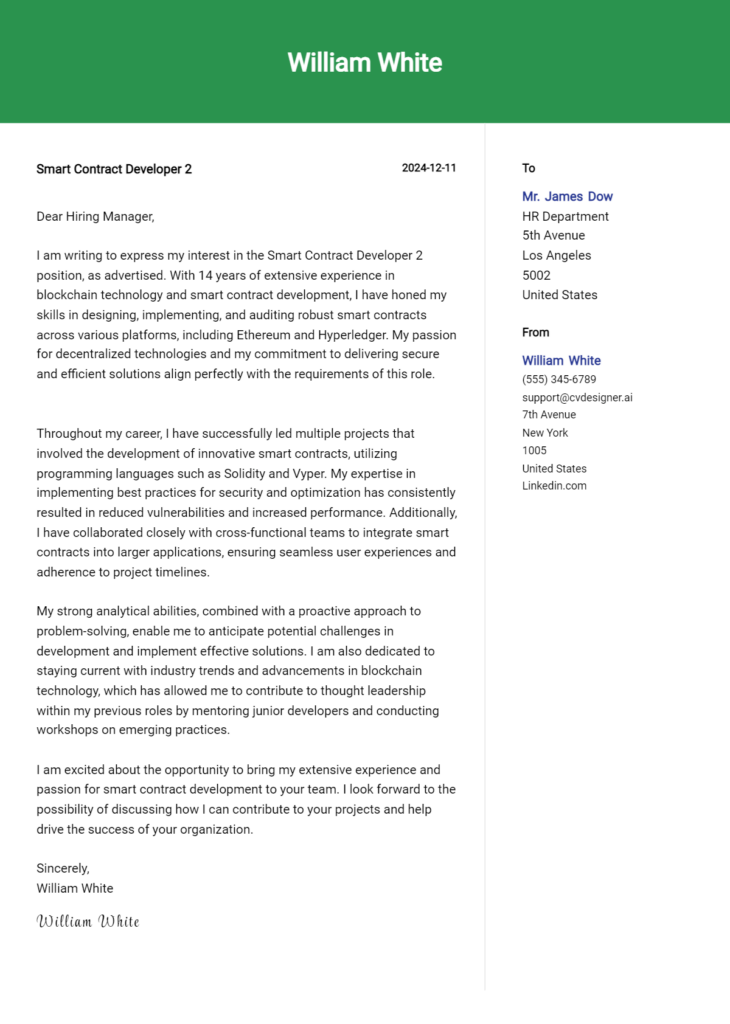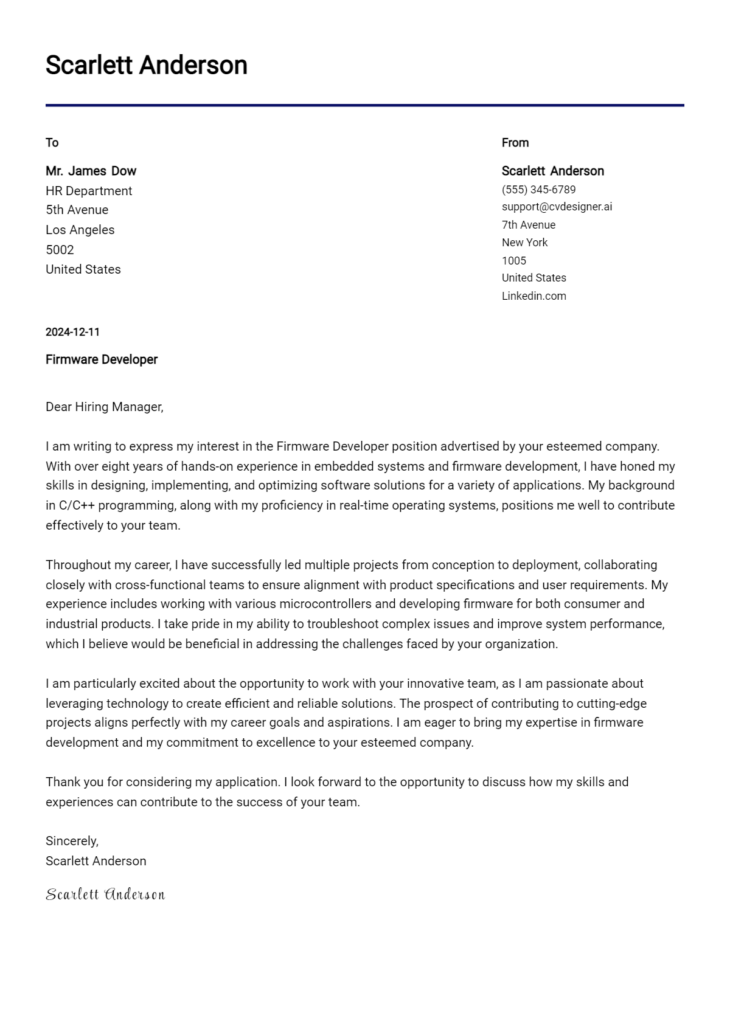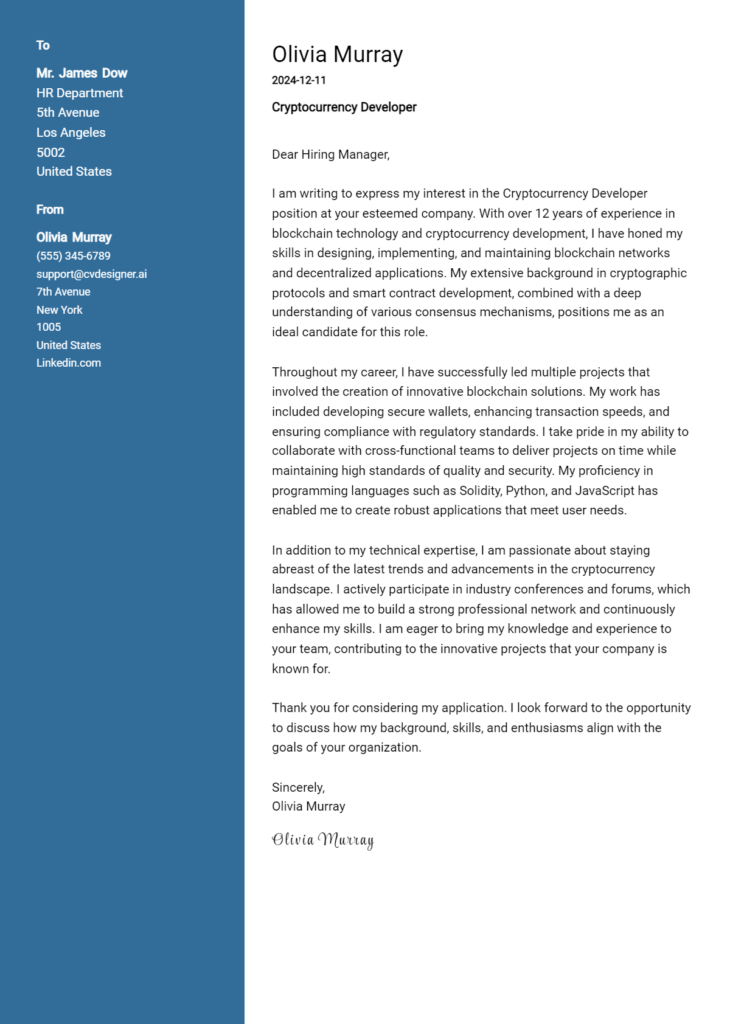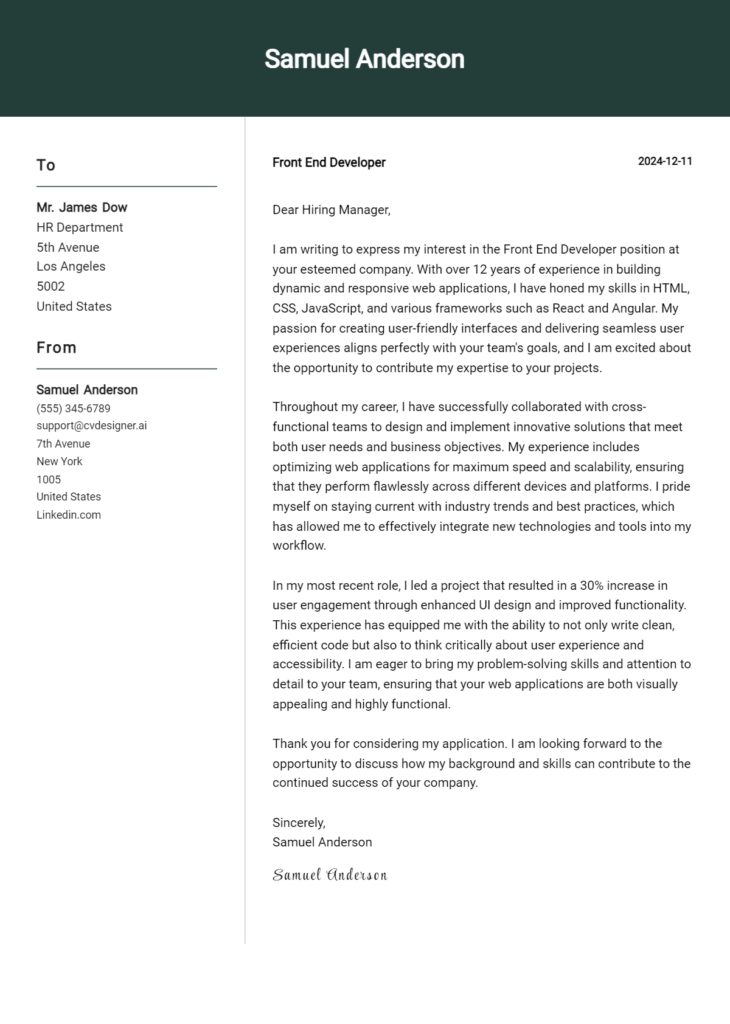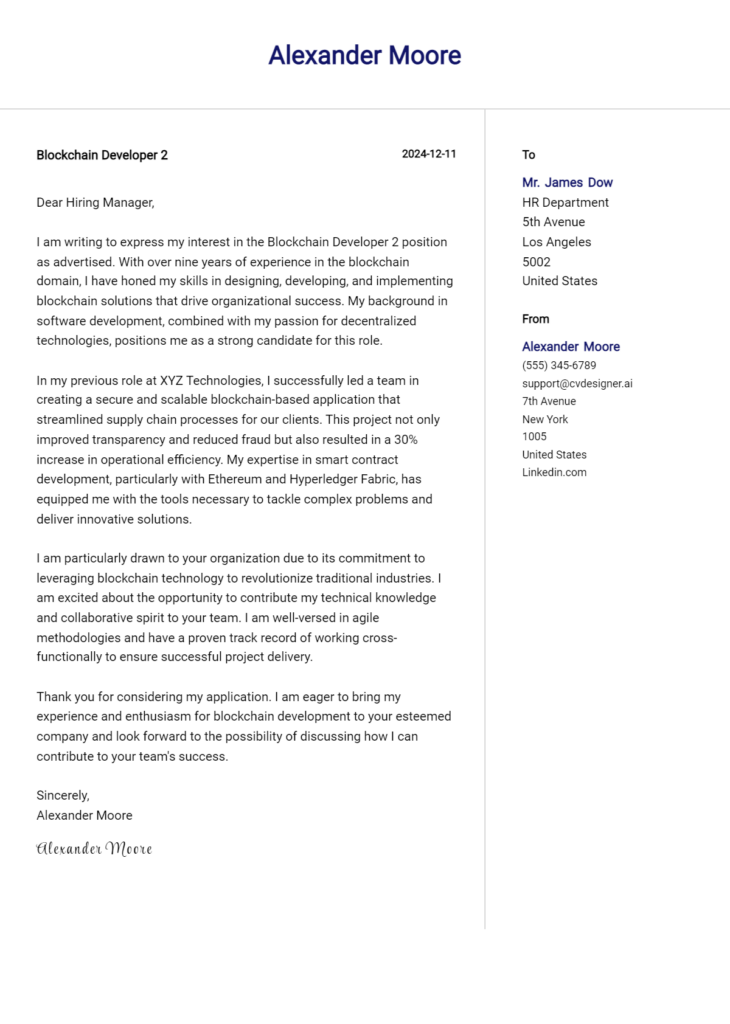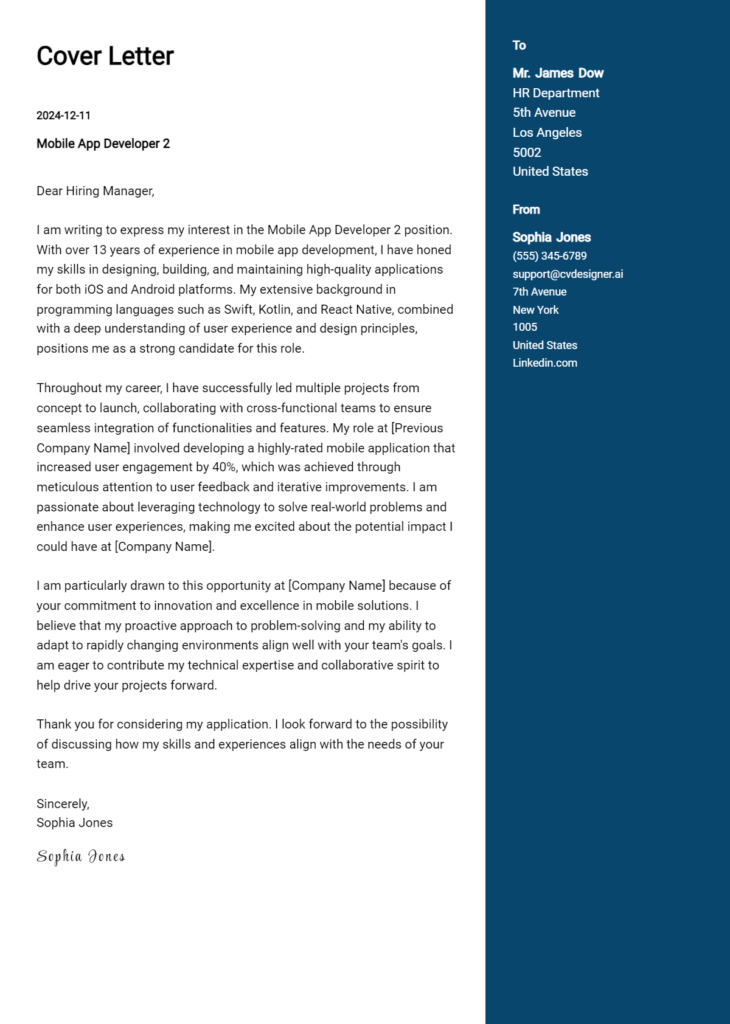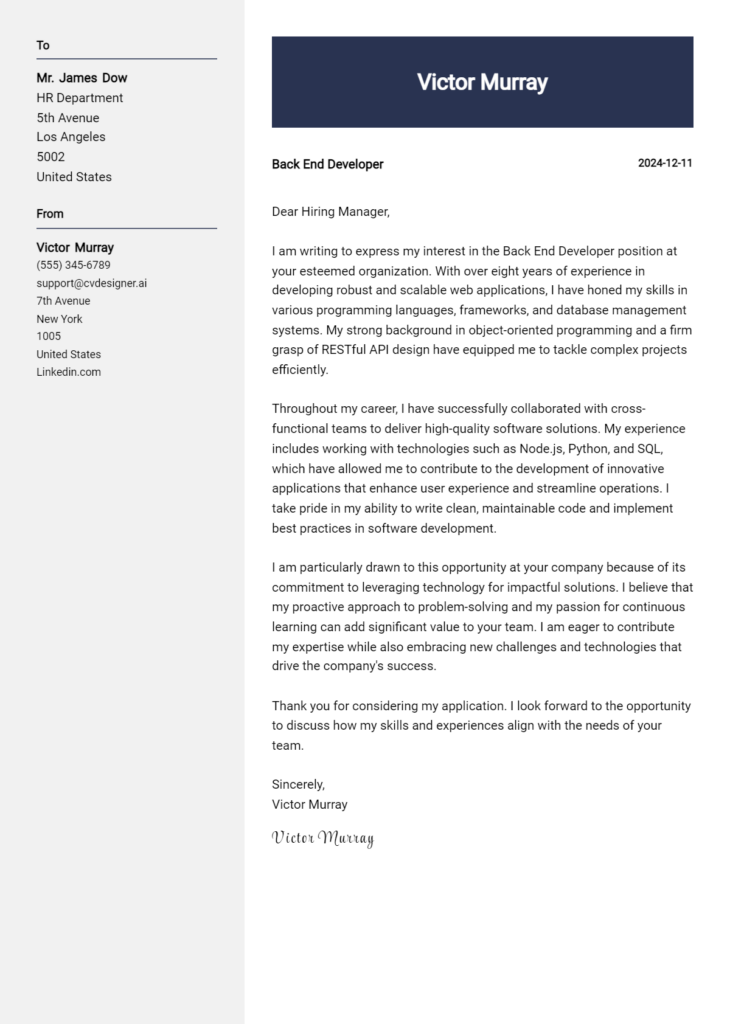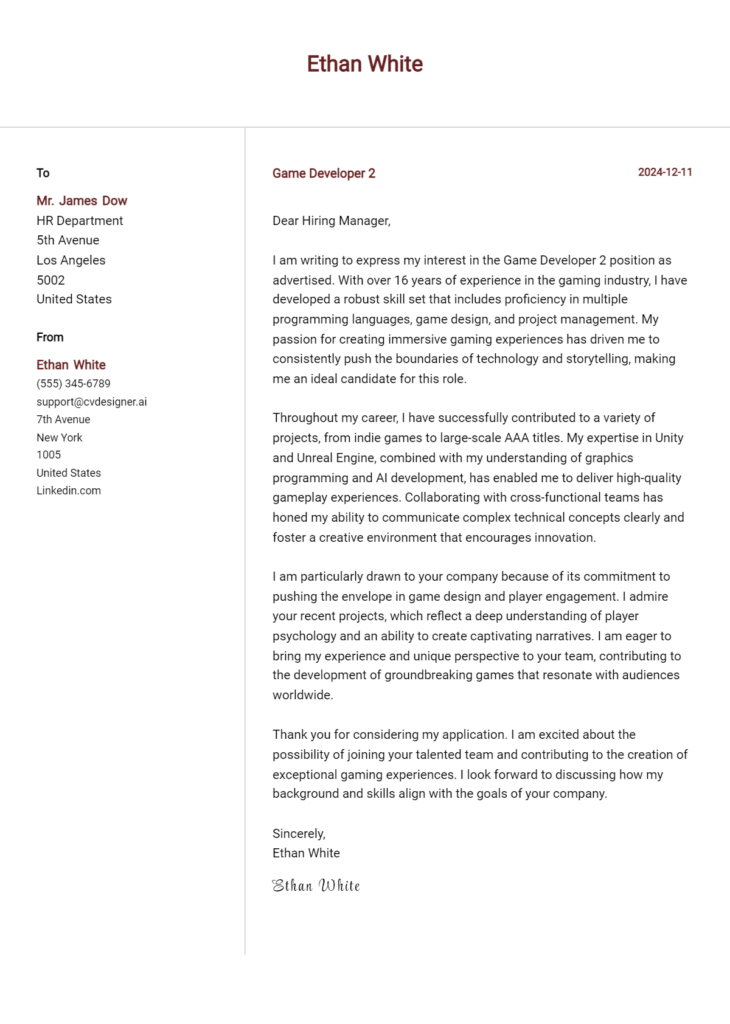Software Developer Cover Letter Examples
Explore additional Software Developer cover letter samples and guides and see what works for your level of experience or role.
How to Format a Software Developer Cover Letter?
Crafting a compelling cover letter is a crucial step for software developers seeking to make a strong impression. The way you format your cover letter not only showcases your technical skills but also demonstrates your ability to communicate clearly and effectively—traits that are essential in the software development field. A well-structured cover letter captures the hiring manager's attention and reflects your professionalism, setting the tone for the rest of your application.
In this guide, we'll outline how to format your cover letter, providing insights and software development-specific examples to help you create a standout document.
We'll focus on the essential components of a professional cover letter, including:
- Cover Letter Header
- Cover Letter Greeting
- Cover Letter Introduction
- Cover Letter Body
- Cover Letter Closing
Each section is vital in emphasizing your qualifications and aligning them with the job requirements. Let’s dive into each part to ensure your software developer cover letter shines.
Importance of the Cover Letter Header for a Software Developer
The cover letter header is a crucial element of any professional correspondence, particularly for a Software Developer. It sets the tone for the application and serves as the first point of contact between you and the potential employer. A well-structured header not only provides essential information but also demonstrates your attention to detail and professionalism. The header should include your contact information, the date, and the recipient's details, ensuring clarity and easy communication. A strong header conveys organization and respect for the hiring process, while a weak header can create a negative impression from the outset.
Strong Example:
John Doe 1234 Software Lane Tech City, TC 12345 johndoe@example.com (123) 456-7890 October 10, 2023 Hiring Manager Tech Innovations 5678 Development Ave Code Town, CT 67890
Weak Example:
john d email@example.com 10/10/23 to whom it may concern
The Importance of the Cover Letter Greeting for a Software Developer
The greeting of your cover letter serves as the initial point of contact with the hiring manager, setting the tone for the rest of your letter. A well-crafted greeting demonstrates both professionalism and personalization, as it shows that you have taken the time to address the recipient directly rather than using a generic salutation. This small yet significant detail can make a lasting impression and encourage the reader to engage more deeply with your application. To enhance your greeting, consider researching the hiring manager’s name through LinkedIn or the company’s website, as this effort reflects your genuine interest in the position. Avoiding generic greetings such as "To whom it may concern" can help you stand out from other candidates.
Strong Greeting Example
Dear Ms. Johnson,
Weak Greeting Example
To whom it may concern,
Importance of a Well-Crafted Cover Letter Introduction for a Software Developer
A well-crafted cover letter introduction is crucial for a Software Developer as it serves as the first impression to the hiring manager. This opening paragraph should not only capture attention but also convey genuine interest in the position. It’s an opportunity to briefly highlight key skills or accomplishments that align with the job requirements, setting the stage for the rest of the letter. A strong introduction can differentiate a candidate from the competition, while a weak one may lead to a missed opportunity.
Strong Example
Dear [Hiring Manager's Name], As a passionate Software Developer with over five years of experience in building scalable web applications, I was thrilled to discover the opening at [Company Name]. My expertise in JavaScript, coupled with my commitment to agile methodologies, has enabled me to deliver high-quality code and drive successful projects. I am excited about the opportunity to contribute to your innovative team and help elevate [Company Name]’s digital solutions.
Weak Example
To Whom It May Concern, I am writing to apply for the Software Developer position. I have some experience with coding and think I could do a good job. I hope you consider my application.
Purpose of the Cover Letter Body for a Software Developer
The cover letter body for a Software Developer serves as a critical opportunity to articulate the candidate's technical skills, relevant experiences, and the unique value they can bring to the company. This section should not only highlight the applicant's proficiency in programming languages and frameworks but also showcase specific projects or accomplishments that demonstrate their ability to solve problems and contribute to team success. A well-crafted cover letter body can effectively convey passion for technology and an understanding of the company’s goals, making a compelling case for why the candidate is the ideal fit for the role.
Strong Example
I am excited to apply for the Software Developer position at XYZ Company. In my previous role at ABC Corp, I led a team project that developed a microservices-based application which improved our deployment times by 40%. My experience with Java and Spring Boot allowed us to create a robust architecture, and I also implemented automated testing using JUnit, which significantly reduced our bug count and increased code quality. Additionally, I contributed to an open-source project that provides a library for data visualization in Python, which has been downloaded over 10,000 times. I am eager to bring my skills in software development and my commitment to teamwork to the talented team at XYZ Company.
Weak Example
I am applying for the Software Developer job. I know how to code in different languages. I worked on some projects before, and I think I would be good for this job. I like technology and enjoy working with computers. I hope to help your company.
Importance of the Cover Letter Closing for a Software Developer
The closing paragraph of a cover letter is crucial as it serves to summarize your qualifications, reiterate your enthusiasm for the position, and encourage the hiring manager to take the next steps, such as reviewing your resume or scheduling an interview. A strong closing can leave a lasting impression and motivate the employer to move forward in the hiring process, while a weak closing may fail to convey your interest or qualifications effectively.
Strong Example
Thank you for considering my application for the Software Developer position at [Company Name]. With my extensive experience in [specific technologies or programming languages], coupled with my passion for creating innovative software solutions, I am excited about the opportunity to contribute to your team. I look forward to the possibility of discussing how my skills can align with your needs. Please feel free to reach out to schedule a conversation at your convenience, and I would be happy to provide further insights into my projects and experiences.
Weak Example
Thanks for reading my letter. I hope you look at my resume. I think I would be a good fit for the job, but I’m not sure. Let me know if you want to talk or something.
These tips will guide candidates in crafting an effective cover letter for a Software Developer position. A well-written cover letter is crucial as it serves as an introduction to your technical skills, problem-solving abilities, knowledge of the Software Development Life Cycle (SDLC), teamwork experience, and your passion for continuous learning. By highlighting these attributes, you can make a strong impression on potential employers.
Tips for Crafting an Effective Software Developer Cover Letter
Showcase Your Technical Skills
Clearly list the programming languages, frameworks, and tools you are proficient in. Tailor this section to match the job requirements by including relevant technologies that the employer is seeking. For instance, if you're applying for a position that emphasizes JavaScript and React, emphasize your experience with those technologies to demonstrate your fit for the role.Highlight Your Problem-Solving Abilities
Employers look for candidates who can tackle challenges effectively. Share specific examples of complex problems you have solved in previous projects. Describe the situation, the actions you took, and the results you achieved. This demonstrates not only your technical capabilities but also your analytical thinking and resourcefulness.Demonstrate Your Knowledge of SDLC
Mention your familiarity with the Software Development Life Cycle. Explain your experience with various phases, such as requirements gathering, design, development, testing, and deployment. This shows that you understand the overall process and can collaborate effectively within different stages of a project.Emphasize Teamwork and Collaboration
Software development is often a team effort, so it's essential to highlight your ability to work well with others. Share experiences where you collaborated with cross-functional teams or contributed to group projects. Discuss how you communicated, resolved conflicts, and contributed to a positive team atmosphere.Express Your Passion for Continuous Learning
The tech industry is constantly evolving, and employers appreciate candidates who are committed to staying current with new technologies and methodologies. Mention any relevant courses, certifications, or personal projects that demonstrate your dedication to continuous learning. This not only showcases your initiative but also signals to employers that you are adaptable and eager to grow.
For additional resources, consider using cover letter templates to structure your letter effectively or a cover letter builder to streamline the writing process.
Common Mistakes to Avoid in a Software Developer Cover Letter
Crafting an effective cover letter is essential for standing out in the competitive field of software development. Avoiding common mistakes can significantly enhance your chances of making a positive impression on potential employers. Here are some common pitfalls to watch out for:
Generic Content: Using a one-size-fits-all approach can make your cover letter blend in with the rest. Tailor your letter to each specific role and company you are applying to.
Neglecting Formatting: A poorly formatted cover letter can distract from your qualifications. Ensure your letter follows a professional cover letter format that is easy to read and looks polished.
Focusing on Duties Instead of Achievements: Many applicants list their job duties instead of highlighting their accomplishments. Use quantifiable metrics to demonstrate your impact in previous roles.
Overloading with Technical Jargon: While you want to showcase your technical expertise, excessive jargon can alienate non-technical readers. Keep it accessible and relevant to the position.
Ignoring the Job Description: Failing to align your skills and experiences with the job description can be detrimental. Make sure to address the specific requirements mentioned in the job posting.
Lack of a Strong Opening: A weak introduction can set a negative tone for the rest of your letter. Start with a compelling hook that grabs the reader's attention.
Not Proofreading: Typos and grammatical errors reflect poorly on your attention to detail. Always proofread your cover letter or have someone else review it before submission.
For further guidance, consider exploring cover letter examples to inspire your writing and ensure you present your best self to potential employers.
Cover Letter FAQs for Software Developer
What should I include in my cover letter as a Software Developer?
In your cover letter, you should include your relevant technical skills, programming languages, and software development methodologies. Begin with a strong introduction that indicates the position you are applying for and how you learned about it. Highlight specific projects or experiences that demonstrate your problem-solving abilities and coding proficiency. It's also beneficial to mention any teamwork experience, as collaboration is often essential in software development. Finally, express your enthusiasm for the company and the role, and conclude with a call to action, inviting them to review your resume or schedule an interview.
How can I tailor my cover letter for different software development positions?
Tailoring your cover letter involves doing a bit of research on the company and understanding the specific role. Start by analyzing the job description to identify the key skills and experiences they are looking for. Use this information to customize your cover letter, ensuring you highlight your most relevant experiences. For example, if the job emphasizes expertise in JavaScript and React, focus on projects where you've successfully used those technologies. Mention specific accomplishments or metrics that align with the company's goals. Additionally, reflect the company culture in your tone and language to show you’d be a good fit.
Should I include my education in my cover letter?
Yes, including your education in your cover letter is important, especially if you are a recent graduate or if your degree is particularly relevant to the role. Mention your degree, the institution you attended, and any honors or relevant coursework that aligns with the job requirements. If you have completed any certifications or specialized training in software development, be sure to include that as well. However, if you have significant work experience, you may choose to briefly mention your education and focus more on your practical skills and professional accomplishments.
How long should my cover letter be for a Software Developer position?
Your cover letter should ideally be one page long, which typically amounts to about 250-400 words. Keep it concise while ensuring you provide enough detail to convey your qualifications and enthusiasm for the role. Use clear and direct language, and avoid unnecessary jargon. Each paragraph should have a specific focus—your introduction, your skills and experiences, and your conclusion. This structure helps maintain readability and keeps the hiring manager engaged. Remember, the goal is to make a strong impression without overwhelming the reader with too much information.
Build your Cover Letter in minutes
Use an AI-powered cover letter builder and have your letter done in 5 minutes. Just select your template and our software will guide you through the process.

